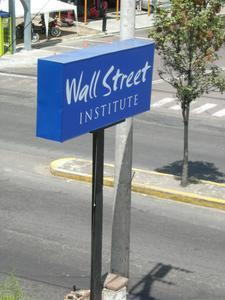Advertisement
Published: February 6th 2007

 Wall Street
Wall Street
These pictures are from the Tumbaco Centre (NOT MINE) about 20 minutes from Quito´s Centre.Lesson of the day from Ecuador: always watch your back near the time of Carnival, which is two weeks away, as people and especially kids LOVE to throw water on you!! I am currently quite wet from walking outside my apartment; luckily it’s a sunny day (about 28 degrees, goes down to around 10 at night) so it felt really nice!!
I couldn’t be happier with my job, the people who are working there, and my apartment (!), which is fantastic. Overview: I started teaching at the Quito Master Centre of the Wall Street Institute (yes, it sounds incredibly American-centric and a bit weird, but the company started in Europe in the late 80s and has spread to like 20 countries with 140 centres worldwide) shortly after I arrived. I was supposed to have more time training - which took me to visit some other centres - but since there was some staff shuffling at our centre and the other 3 in Quito, they needed me right away. I’m really enjoying the teaching part of it. It’s not really like regular classroom instruction, more like tutoring with only about 1-5 people per class, helping people with problems they have with
the unit they’re working on.
The program works in such a way that the students (ages 14-adult) spend time in the computer lab listening and speaking with a program designed specifically for Wall Street, which follows a series of characters through 68 units. The program is very much like a soap opera, there’s lots of love interests, deception, foreign diamond trade, and a host of characters that not only exude the stereotypes of the ethnicity they are, for example there’s a Japanese girl who talks very slowly and always gets her L’s and R’s mixed up, but just amuse me to no end. I think it does keep the students interested though. So, then they do some activities in their workbook which drive home the vocabulary and grammar points from the unit, then they have an ‘Encounter’ with the teachers, who are about half native speakers, half Ecuadorian. There are also mandatory supplementary classes, called complimentary classes, where we basically just get the students to talk and do activities to promote fluency. As you can see, it’s not really traditional language instruction, there are no purely grammar lessons, it’s all learned within the context of actually speaking and listening
to English.
The students come from very diverse backgrounds. They do have to pay for this instruction, so they do tend to be middle class people. I’ve had doctors, lawyers, people from a variety of international NGOs, engineers, and lots of university students. For the most part, they are, of course, educated and thus we can have really interesting discussions about of variety of topics like politics, social issues, and Ecuador in general, in the complimentary classes. It’s all very interesting!!
I found an apartment in the south part of the city in the hills in the east. I’ve uploaded some pictures to the ‘Gallery’ section of the blog site. It’s really easy to get anywhere I want to go in the city (about 15 minutes to work) and, as you’ll see, the view is incredible!! I’m also really near the old town, which is spectacular (a UNESCO heritage site), and the central market - when we had Mexican night on Friday, I picked up the makings for a big bowl of guacamole for about $1.75!!
On the note of prices, the currency here is USD, switched in the early 2000s when the Ecuadorian Sucre was fluctuating

 Tumbaco Classrooms
Tumbaco Classrooms
Ours look very similar to this, glass walls with a table and chairsso much that prices of things could double within a few days! I’ve heard people complain that it’s harder since the introduction of the USD because the price of things generally went up, but their salaries remained relatively the same. However, things are generally cheaper than home, especially produce, but it does tend to be one of the most expensive countries in South America I’m told.
I’m learning Spanish (¡Hola!) from my landlord, Eli, whose family has been incredibly amazing to me. I’ve been to their place for dinner numerous times and they are doing everything to make me feel so comfortable and good about being here. They just live about a 3 minute walk from my place.
Well, in a word, how is Ecuador? Fantastic!! If things continue to go like this, it’s going to be a fantastic year. There’s loads more to do…I’ll do my best to keep up to date with this thing, maybe a tad more frequent and definitely truncated!! All the best back in Canada, or wherever you may be and till next time, adios!!
Advertisement
Tot: 0.09s; Tpl: 0.011s; cc: 7; qc: 46; dbt: 0.0687s; 1; m:domysql w:travelblog (10.17.0.13); sld: 1;
; mem: 1.1mb















mom and dad
non-member comment
wow!!!
this really looks like a place we should visit!!!